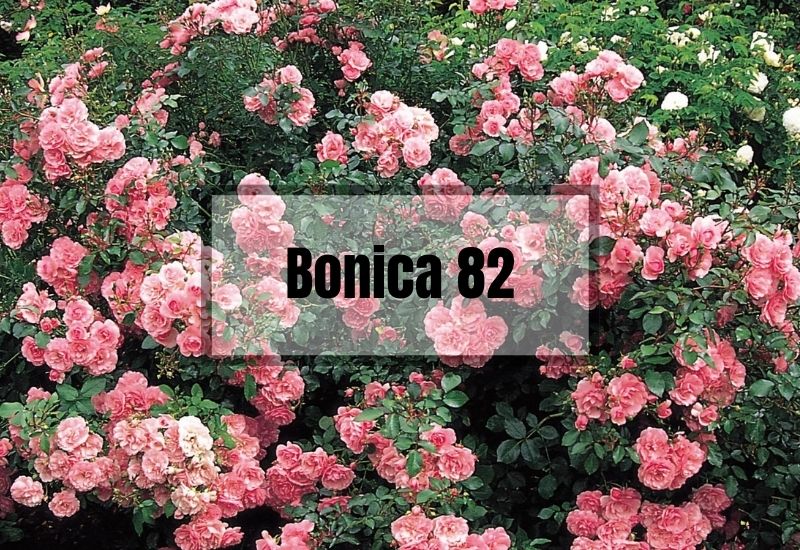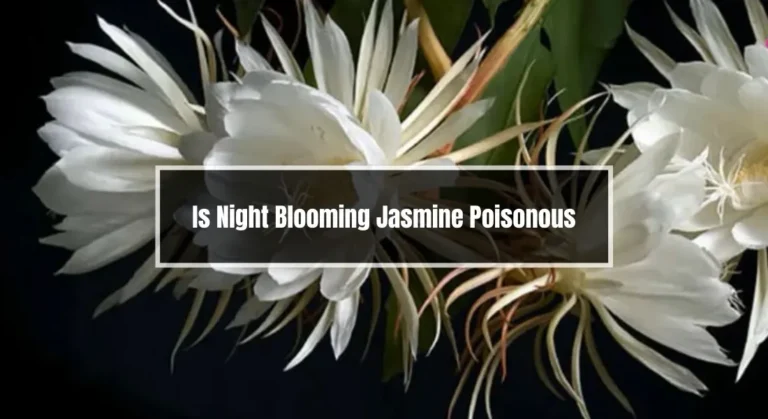All You Need to Know About the Bonica 82
Hey there, flower lovers! Today, I’m going to talk about one of my favorite flowers, the Bonica 82. This versatile flower has been a popular choice for gardeners and flower enthusiasts for years, and for a good reason. In this blog post, I’ll tell you everything you need to know about the Bonica 82, from its history to its growing conditions, benefits, and maintenance tips. So, let’s get started!

What is Bonica 82 And Origins
The Bonica 82 flower is a widely grown variety of the Rosa genus, which belongs to the Rosaceae family. Meilland International, a company in France, developed the Bonica 82 flower by crossing Rosa sempervirens and Rosa canina in the 1970s. The flower got its name from the wife of the company’s head, Francis Meilland, and the number 82 represents the year of its introduction to the market.
The Bonica 82 flower is a low-maintenance and disease-resistant shrub that can grow up to 4-6 feet tall and wide. Its pink blooms are small, fragrant, and form clusters that bloom continuously from summer to fall. The flowers have a high petal count and double bloom, giving them a fluffy and full appearance. They produce a mild and sweet fragrance, making them attractive to bees, butterflies, and other pollinators.
In addition to its blooms, the Bonica 82 flower has dark green, glossy foliage that is slightly serrated and oval-shaped. Its leaves can remain on the plant during winter in mild climates, making it an evergreen plant. It can also develop small, red hips, which add interest to the winter landscape.
The Bonica 82 flower is a popular choice for gardens due to its beauty, low maintenance, and disease-resistant qualities. It is versatile and compact, making it ideal for use in borders, hedges, mass plantings, and as a groundcover. It also makes an excellent container plant for patios and decks.
Similar varieties of the Bonica 82 flower include the Bonica 76, Bonica Meidomonac, and Bonica 91. These varieties have similar traits, such as disease resistance, low maintenance, and abundant blooms. However, they may differ in color, fragrance, or size. For example, the Bonica 76 has a slightly more compact growth habit and smaller flowers, while the Bonica Meidomonac has a deeper pink color and a stronger fragrance.
Best Environment and Growing Conditions for the Bonica 82 Flower:
The following is a guide for growing and caring for the Bonica 82 flower. This flower is known for being a hardy and adaptable plant that can thrive in various conditions. The tips below will help you ensure that your Bonica 82 flower stays healthy and vibrant:
The Bonica 82 flower can grow in temperatures ranging from -10°C to 40°C, making it suitable for different climates. It prefers a location that receives partial shade with a good amount of sunlight, and well-drained soil with a pH level ranging from 5.5 to 7.5. It is crucial to make sure that the soil does not become waterlogged, as this can lead to root rot.
Steps to Plant and Care for Bonica 82 Flower:
Planting
Choose an area with soil that drains well, and dig a hole that is twice the size of the root ball. To provide additional nutrients, mix compost or organic matter into the soil. Place the plant in the hole and backfill with soil, gently pressing it down.
Watering
Deeply water the plant once a week or more frequently during hot, dry weather. To avoid fungal diseases, refrain from getting water on the foliage.
Fertilizing
Use a balanced fertilizer to feed the plant once a month during the growing season.
Pruning
To promote new growth and maintain the plant’s shape, prune the Bonica 82 flower in early spring by removing any dead or damaged branches.
Common Issues and Diseases, and How to Deal with Them
Powdery Mildew
This fungal disease manifests as a white, powdery coating on the leaves. To prevent powdery mildew, ensure that the plant receives good air circulation and avoid overhead watering. If powdery mildew occurs, remove the affected leaves and treat the plant with a fungicide.
Black Spot
This fungal disease appears as black spots on the leaves. To prevent black spot, make sure the plant has proper air circulation and avoid overhead watering. If the plant is affected, remove the affected leaves and treat with a fungicide.
Aphids
These small, sap-sucking insects can cause the plant to become stunted and distorted. To control aphids, use a jet of water to knock them off, or use an insecticidal soap.
Disease Resistance and Easy Maintenance of Bonica 82
Bonica 82 is known for its disease resistance, which is a significant benefit for gardeners. This flower is resistant to various diseases, including black spot and powdery mildew, which can cause other roses to wilt and die. Additionally, Bonica 82 is relatively easy to maintain. As with most roses, all it needs is good drainage, and it will thrive with little else.
Organic mulch or compost mulch will enrich the soil, and slow-release fertilizer made especially for roses can be added to give it a lift. Bonica 82 can tolerate a little shade, but it’s best to ensure it gets at least 6 hours of sun every day.
Following these guidelines will help you care for your Bonica 82 flower properly. By doing so, you can enjoy a beautiful and healthy plant that will add vibrancy to your garden or landscape.
Uses and Benefits of Bonica 82 Flower
The Bonica 82 flower is a well-liked option for enhancing the beauty of a garden or outdoor space due to its attractive appearance and ease of cultivation. As a hardy perennial, it blooms heavily in the summer and fall, generating clusters of delicate pink flowers that can grow up to 3 inches in diameter.
The Bonica 82 flower can be utilized in a variety of ways to beautify a garden, including planting it as a border plant, in mass plantings, or in a container garden. Additionally, the Bonica 82 flower can be used as a cut flower or in floral arrangements.
Apart from its decorative uses, the Bonica 82 flower is also valued for its medicinal properties. Its flowers are abundant in antioxidants, which can help to prevent cell damage and reduce inflammation. In traditional medicine, Bonica 82 flower extracts have been utilized to treat several ailments, including arthritis, joint pain, and skin irritation.
Moreover, the flower is acknowledged for its antibacterial properties, making it useful in the treatment of infections.
The Bonica 82 flower is also edible, and its petals can be utilized in cooking to add color and flavor to dishes. They can be used as a garnish in salads or cocktails or can be brewed to create teas or infused oils. These oils can be employed in cooking or as a natural remedy for various ailments.
Overall, the Bonica 82 flower is a flexible plant that has several advantages, including aesthetic and health benefits. Whether utilized for decorative purposes, medicinal applications, or culinary uses, the Bonica 82 flower is a stunning and valuable addition to any outdoor space or garden.
Interesting Facts and Trivia about Bonica 82 Flower
The Bonica 82 flower is a plant known for its versatility and beauty, with unique characteristics that make it stand out. Below are some lesser-known facts and trivia about this beloved flower:
- Origin: Developed in 1982 by Meilland International, a French rose breeding company, the Bonica 82 flower is a hybrid of Rosa sempervirens and Rosa wichuraiana.
- Awards: This flower has won several awards, including the prestigious All-America Rose Selection (AARS) award in 1987 and was named “World’s Favorite Rose” in 1997.
- Resilience: The Bonica 82 flower is known for its ability to adapt to a wide range of growing conditions, making it a popular choice for landscaping and gardens. It can tolerate drought, heat, and cold.
- Blooming: During the growing season, the Bonica 82 flower produces clusters of small pink flowers with a sweet fragrance. Each cluster can contain up to 30 flowers, and the plant blooms repeatedly.
- Size: This flower can grow up to 4 feet tall and wide, making it ideal for hedges, borders, and mass plantings.
- Disease Resistance: The Bonica 82 flower is highly resistant to diseases like black spot and powdery mildew, which can plague other types of roses.
- Symbolism: The Bonica 82 flower is often associated with appreciation, gratitude, and love, and it’s a popular gift for special occasions like Mother’s Day.
- Crossbreeding: The Bonica 82 flower has been extensively used in crossbreeding programs to develop new varieties of roses that have similar characteristics, such as disease resistance and multiple blooms.
Overall, the Bonica 82 flower is a fascinating and versatile plant with a rich history and many exciting characteristics. Whether you’re a gardener or just appreciate the beauty of flowers, the Bonica 82 is undoubtedly worth exploring further.
Frequently Asked Questions (FAQs)
What is the meaning of the name Bonica 82 flower?
The name “Bonica” is derived from the Latin word “bonus”, which means good. The “82” refers to the year of introduction, which is 1982. So, the name Bonica 82 indicates that this flower is a good variety that was introduced in 1982.
Can Bonica 82 flowers be grown indoors?
While Bonica 82 flowers can be grown indoors, they thrive better in outdoor environments where they can receive plenty of sunlight and fresh air. If you choose to grow them indoors, it is recommended that you place them near a window or in a well-lit area to ensure they receive enough light. Additionally, make sure to provide them with proper drainage and soil conditions.
How long does the Bonica 82 flower bloom?
The Bonica 82 flower typically blooms in late spring and early summer and continues to bloom throughout the growing season until the first frost. With proper care, the plant can produce a second flush of blooms later in the season.
How do I prune my Bonica 82 flower?
To keep your Bonica 82 plant healthy and promote continued blooming, pruning is essential. Prune the plant after the first bloom cycle has ended, cutting back the stems by about one-third of their length. Deadheading the spent flowers throughout the growing season can also help to promote more blooms. Make sure to use clean and sharp pruning tools to prevent damage to the plant.
Are Bonica 82 flowers toxic to pets?
No, the Bonica 82 flower is not toxic to pets. However, if ingested in large quantities, it may cause mild gastrointestinal upset such as vomiting or diarrhea. As with all plants, it is important to keep them out of reach of pets to prevent accidental ingestion.
Conclusion
In conclusion, the Bonica 82 is a beautiful and versatile flower that is perfect for any garden. It’s a popular choice for gardeners and flower enthusiasts due to its disease resistance, long bloom time, and easy maintenance.
Whether you want to plant it as a single plant, in clusters, or in containers, Bonica 82 will add beauty and elegance to your garden. By following the tips provided in this blog post, you can grow and care for a healthy Bonica 82 and enjoy its stunning blooms year after year.
Related Posts:
- Mastering Cabbage Rose Care: Protecting Against Common Pests & Diseases
- Unveiling the Secrets of Rosa Persica: Its Origins, Uses, and Care Techniques
- Pruning for Better Blooms: The Ultimate Guide to Deadheading Miniature Roses
- Indoor Miniature Rose Woes? A Thorough Troubleshooting Guide for Common Problems





